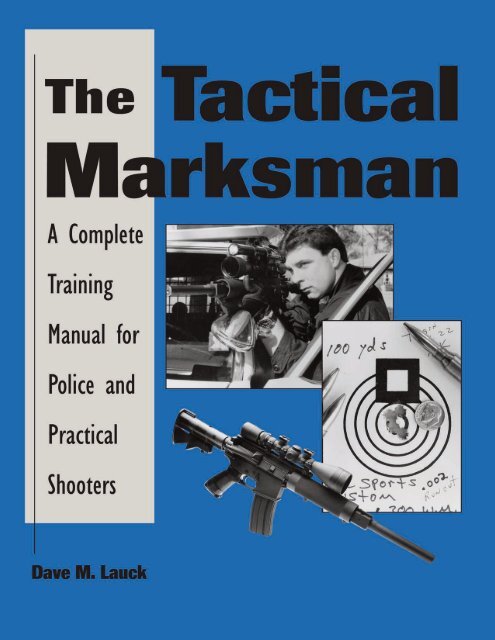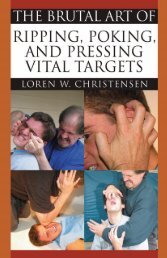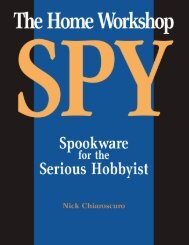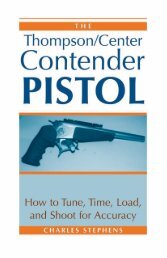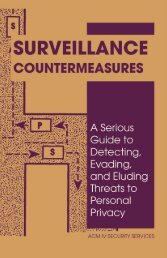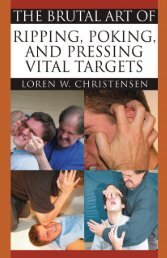to read a free sample chapter from this book. - Paladin Press
to read a free sample chapter from this book. - Paladin Press
to read a free sample chapter from this book. - Paladin Press
Create successful ePaper yourself
Turn your PDF publications into a flip-book with our unique Google optimized e-Paper software.
ContentsPrefaceixIntroduction 1Chapter 1 Safety 3Chapter 2 The Tactical Marksman Concept 9Chapter 3 Rifle Selection 13Chapter 4 Optics and Support Equipment 39Chapter 5 Ballistics and Ammunition 65Chapter 6 Zeroing 87Chapter 7 Rifle Marksmanship 103Chapter 8 Close-Action Rifle 113Chapter 9 Practical Rifle Training 127Chapter 10 Rifle Maintenance 141Appendix A Sample Field Data Book 147Appendix B Sample Cold Shot Target 151Appendix C List of Suppliers and Training Schools 153Glossary 155v
WarningFIREARMS AND FIREARMS TRAINING ARE POTENTIALLY DANGEROUS AND MUST BEhandled responsibly by individual opera<strong>to</strong>rs. The technical information presentedhere on training, gunsmithing, and shooting inevitably reflects the author’sbeliefs and experience with particular firearms, equipment, and components underspecific circumstances that the <strong>read</strong>er cannot duplicate exactly. The information in<strong>this</strong> <strong>book</strong> is therefore presented for academic study only and should be approachedwith great caution. Neither the author nor the publisher assumes any responsibilityfor the use or misuse of information contained in <strong>this</strong> <strong>book</strong>.Firearms possession and use are regulated by the federal Bureau of Alcohol,Tobacco, and Firearms, as well as various state and local statutes. Stiff penalties andpossible imprisonment can result <strong>from</strong> failure <strong>to</strong> obey these laws. It is your responsibility<strong>to</strong> find out which laws apply before buying or using any firearm.vi
SafetyChapter1IF YOU ARE THE OWNER OF A FIREARM, WHETHER FOR SPORT, DEFENSE, OR SPECIALoperations, you are responsible for its safe handling and s<strong>to</strong>rage. The though<strong>to</strong>f being responsible for a careless death, by your hand or another’s, because of afirearm you failed <strong>to</strong> s<strong>to</strong>re properly should be enough incentive <strong>to</strong> make you constantlyaware of and strive for safety.Firearms themselves are repeatedly blamed for the results of human carelessnessand criminal activity. Except for extremely rare cases, assigning blameis just an attempt <strong>to</strong> escape responsibility for a mistake or criminal conduct.Outside of the general improbability of any mechanical malfunction of thefirearm-ammunition combination, you, the weapons opera<strong>to</strong>r, have sole controlover the safety of the firearm. Following a few basic rules of gun handling ands<strong>to</strong>rage can virtually eliminate the so-called accidental discharge. Information in<strong>this</strong> <strong>chapter</strong> will help <strong>read</strong>ers understand that the “accidental discharge” is, inreality, a careless or unintentional discharge.ALL GUNS ARE ALWAYS LOADEDThis idea needs <strong>to</strong> be taken seriously at all times. Provided that it is, theweapon will be handled properly, and there will never be need <strong>to</strong> claim “I didn’tknow it was loaded” after a mishap. All guns are always loaded and shouldalways be controlled.DO NOT LET YOUR MUZZLE COVER ANYTHINGYOU ARE NOT WILLING TO DESTROYThis simple statement says it all. Don’t add anything <strong>to</strong> it, such as, “Don’t let themuzzle of your loaded gun cover anything you are not willing <strong>to</strong> destroy.” Theymust never cover anything you are not willing <strong>to</strong> take the responsibility for destroying.Just because your firearm is not covering anyone in your immediate area doesnot mean it is not covering anyone in another area or structure. The penetrative3
4 The Tactical MarksmanA <strong>read</strong>y but safe boltposition for target areacoverage. Do not lockdown unless the situationrequires it.power of a bullet, especially a high-powered riflebullet, needs <strong>to</strong> be kept in mind at all times. Safemuzzle control means not covering any undeservingperson, including yourself. When you caseyour rifle or holster your pis<strong>to</strong>l, control your muzzle.When using your long gun and wearing asidearm, be aware of the muzzle directions of both.A poor sidearm holster selection can position yourpis<strong>to</strong>l so that it is pointed at you; and in some rifleshootingpositions, inattention <strong>to</strong> your holsteredpis<strong>to</strong>l’s position can lead <strong>to</strong> covering others in thearea, such as the range officer behind the prone firingline.The tactical marksman must develop a techniquefor being instantly prepared <strong>to</strong> fire withoutviolating <strong>this</strong> or other safety rules. The bolt-action rifle can be fully loaded and keptat the “safe <strong>read</strong>y” by keeping the bolt handle raised and the firing pin locked inplace. The muzzle should be directed <strong>to</strong> a safe area, and the bolt handle should notbe closed until a shot is justified. The fully loaded semiau<strong>to</strong> rifle can be kept at the<strong>read</strong>y by activating the manual safety and keeping the muzzle off target in a safearea. Do not directly view targets through a mounted rifle scope unless the action isjustified. Thoroughly test your equipment <strong>to</strong> ensure that it will not unintentionallydischarge during a hard, fast-bolt lockdown or deactivation of the manual safety.This is especially important under extreme cold conditions where improper lubricationcan cause weapons <strong>to</strong> <strong>free</strong>ze up.KEEP YOUR FINGER OFF THE TRIGGER UNTIL YOUR SIGHTSARE ON THE TARGET AND YOU ARE PREPARED TO FIREHaving your finger on the trigger before your sights are aligned is an unintentionaldischarge waiting <strong>to</strong> happen, especially with a finely tuned rifle trigger. If youare justified in shooting a target, align your sights on the target before placing yourfinger on the trigger. Until your sights are aligned your shot placement is not confirmed.An unintentional shot could be disastrous. Properly trained shooters developa trigger finger that operates separately <strong>from</strong> the grip pressure of the rest of thehand. A well-trained trigger finger is not prone <strong>to</strong> unintentionally releasing the shot,even when the shooter is startled.BE SURE OF YOUR TARGET AND WHAT IS BEYONDThis is a simple yet effective statement that all <strong>to</strong>o often goes unheeded. Youdo not shoot at noises, shadows, or movements. You must identify your targetand confirm a safe backs<strong>to</strong>p behind your target before firing. For the tacticalmarksman in a hostage situation, for instance, <strong>this</strong> may be an exacting task:hostage takers using disguises and/or live shields can make <strong>this</strong> extremely difficultat times. Nevertheless, the rule must be adhered <strong>to</strong>. On occasion, the tacticalmarksman will have <strong>to</strong> adjust his position <strong>to</strong> ensure a safe backs<strong>to</strong>p—as in
Safety5increasing the angle of the shot <strong>to</strong> use the ground as a backs<strong>to</strong>p. Increasing theangle of the shot and the difficulty of the shot’s calculation require advancedtraining <strong>to</strong> guarantee proper performance.ALWAYS WEAR YOUR SAFETY EQUIPMENTEye and ear protection are a must while shooting. Your shooting glasses shouldbe made out of shatter-resistant material. Quality glasses will not only provide protectionwhile firing, but they will also give some protection should you be firedupon. If an adversary decides <strong>to</strong> search your area by fire, quality eye protection willreduce damage <strong>from</strong> secondary projectiles.The lenses should be dis<strong>to</strong>rtion-<strong>free</strong> when they are looked through <strong>from</strong> anyangle (some glasses will have dis<strong>to</strong>rtion at severe angles, such as in prone shootingat high angles). The frame should also be unobtrusive so that it will not interferewith <strong>to</strong>p and side vision. Strength, comfort, and low reflectivity are all extremelyimportant considerations. Blindshooters will have problemscompleting their missions. Wearyour glasses.Ear protection has alwaysbeen a problem for the tacticalmarksman, who must be alert <strong>to</strong>his surroundings and communications,yet must protect hishearing. The best developmentin <strong>this</strong> area is electronicearplugs. These inside-the-eardevices protect your ears <strong>from</strong>harsh noise, enhance your ability<strong>to</strong> hear low-level sounds, andoutperform electronic muffsbecause the plugs are less cumbersomeand allow proper head<strong>to</strong>-s<strong>to</strong>ckpositioning.Entry team personnel will also benefit <strong>from</strong> these high-tech hearing protec<strong>to</strong>rs.Enhanced hearing with instant shutdown/turn-on works well for explosive andflash-bang entries, not <strong>to</strong> mention eager teammates who fire beside your head.The drawback, as with other quality equipment, is the price, which is approximately$500 per set. In addition, the earplugs have <strong>to</strong> be individually form-fitted bya professional.Always wear personalsafety equipment duringlive fire and carry firstaidsupplies in your gear.DRUGS AND ALCOHOL DO NOT MIX WITH FIREARMSThough <strong>this</strong> should be obvious, the rule is often ignored. An unintentional discharge<strong>from</strong> the firearm of a shooter who is under the influence of drugs or alcoholwill not give him a legal leg <strong>to</strong> stand on in the event of damage <strong>to</strong> persons or property.Any tactical unit on 24-hour call, for example, should have a standing order of
6 The Tactical Marksmanno drug or alcohol consumption at any time. A tactical officer who reports for dutyknowing that he has consumed alcohol or drugs (including any legally prescribed orover-the-counter medication that impairs judgment or reflexes) must be responsibleenough <strong>to</strong> immediately report the information <strong>to</strong> the commander and worry aboutthe consequences later.DO NOT LEAVE YOUR WEAPON UNATTENDEDYou are responsible for the security of your firearms. Unsecured firearms haveled <strong>to</strong> the wounding or death of many children and the gain of many criminals. Ifyou are not in direct control of your firearm, it should be under lock and key. Glassdisplay cases, including the rear windows of pickup trucks, are not secure; get asecure vault.If you are a tactical officer, ensuring that your equipment is secured is not merelya question of safety. Any time your equipment is out of your direct control, youcannot be confident that it is undisturbed: curious or destructive personnel maytamper with your equipment while you are not present. This means that anytimeyou are away <strong>from</strong> your unsecured equipment, you must examine it and confirm thezero before its duty use.ASSIGN A QUALIFIED RANGE OFFICERShooting takes concentration, and dangerous situations developing at the rangemay go undetected by the occupied shooter. A competent range officer is able <strong>to</strong>detect unexpected range developments, such as a person appearing in the impactarea, before problems occur. The range officer can also assist with any medical emergenciesor injuries the lone shooter may otherwise incur.SELECT A PROPER RANGEYour range selection must be suitable for the firearms you are shooting. A positivebacks<strong>to</strong>p is a must. Range targets, especially now that steel targets are popular,must be suited <strong>to</strong> the firearm you are using. Damaged steel targets may cause seriousbullet fragments, which can spatter back at persons on the range.DO NOT SACRIFICE SAFETY FOR ANY ADVANTAGEDo not cut corners on safety procedures in an attempt <strong>to</strong> gain a shooting edge.This is especially true with equipment modifications, such as trigger-pull adjustments.Excessively light, unreliable trigger engagements are completely unsuitablefor tactical missions. Gun-handling techniques that violate safety rules in a quest formore speed must not be used. Unsafe ammunition, no matter what spectacular performanceis claimed for it, must not even be considered.KNOW YOUR EQUIPMENTFully understanding your equipment will allow you <strong>to</strong> recognize any emerging
Safety7problems and apply the proper preventive maintenance. You must be familiar withyour equipment and its operation <strong>to</strong> the point that you can operate in the dark withit. Lack of familiarity with your equipment can cause serious lag time when quickoperation is required. Placing your shots correctly is only a matter of luck if youdon’t fully understand your equipment. Don’t base your mission on luck.AMMUNITION SAFETYRifle ammunition should be of the highest quality available and consistently thesame for training, duty, or match use. Improperly manufactured ammunition can beextremely unsafe, especially in high-pressure rifle cartridges. Unless you are a professionalprecision handloader, stay with new fac<strong>to</strong>ry-loaded match ammunition.All cartridges, whether fac<strong>to</strong>ry- or handloaded, should be gauged, weighed, andinspected prior <strong>to</strong> duty carry. Specific ammunition is part of your shooting system:it must remain consistent <strong>to</strong> keep your performance <strong>from</strong> varying drastically.Maintain strict control over your ammunition lots.MALFUNCTIONS AND SAFETYThere is a reason for every malfunction. If your firearm malfunctions regularlyand you don’t know the cause, have it inspected by a competent armorer. Yourfirearms should be proven reliable before you take them on duty carry: <strong>this</strong> does notmean someone telling you that the firearm works. Any time your weapon is out ofyour control, such as for an armory inspection, carefully examine, test-fire, andrezero it when you get it back.Malfunctions on a mission can be disastrous, and they are compounded byimproper clearance procedures. Do not try <strong>to</strong> fire through barrel obstructions. Thereshould be no need <strong>to</strong> forcibly operate your weapon if proper clearance proceduresare used. If you are well trained in your firearm’s operation, safely clearing s<strong>to</strong>ppagesshould be a simple task. Should you become a victim of Murphy’s Law, beprepared <strong>to</strong> make a fluid transition <strong>to</strong> your support (backup) weapon.• • •Good safety habits will become second nature if they are always observed.Safe habits are extremely important in high-stress encounters; unintentionallyshooting yourself or your partner will do little <strong>to</strong> help you survive the mission.Make safety a habit at all times!


